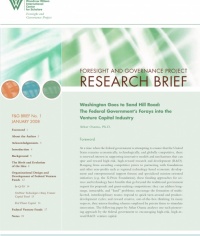How Will Government Spur Technological Innovation In The 21st Century?
New white paper offers analysis of public venture capital funding mechanisms
 Washington, DC — At the January 22nd Congressional Nano Caucus briefing, project director David Rejeski recommended the establishment of a federal venture capital fund to speed the development and commercialization of green nanotechnology applications. This follows on a background white paper on government-run VC funds just released by the Woodrow Wilson Center’s Foresight and Governance Project.
Washington, DC — At the January 22nd Congressional Nano Caucus briefing, project director David Rejeski recommended the establishment of a federal venture capital fund to speed the development and commercialization of green nanotechnology applications. This follows on a background white paper on government-run VC funds just released by the Woodrow Wilson Center’s Foresight and Governance Project.
from The Foresight and Governance Project :
Renewed interest in federal support for high-risk, high-reward research and development requires a re-evaluation of federal venture capital programs, concludes a new white paper released today by the Foresight and Governance Project at the Woodrow Wilson International Center for Scholars. Innovative funding models developed by the Central Intelligence Agency, National Aeronautics and Space Administration and the Army offer blueprints for encouraging the development of new technologies, but a new framework is needed to guide the creation of public sector venture capital programs in the future.
The white paper, Washington Goes to Sand Hill Road: The Federal Government’s Forays into the Venture Capital Industry, was written by Dr. Athar Osama, a senior consultant for the United Kingdom-based consulting and venture capital firm ANGLE Plc. and a former doctoral fellow at the RAND Corporation.
“Innovative funding approaches for science and technology have benefits that go beyond the traditional government approaches to grant making,” says David Rejeski, director, and Evan Michelson, research associate, at the Foresight and Governance Project. “These approaches can address long-range technological challenges, create dynamic and interdisciplinary teams, and reward creative, out-of-the-box thinking.”
But government-funded venture capital efforts cannot operate like similar private-sector models. “More often than not, managers of non-traditional venture-creation programs cannot be incentivized through financial rewards,” says Dr. Osama. “This can reduce their motivation to succeed. Understanding how differences in incentive systems play into the process is important for the design of a successful program.”
In the paper, Dr. Osama offers criteria that could help design effective public sector venture funding initiatives. These criteria include policy and business objectives; relationships with other sources of capital and ideas; investment philosophy; management style and operating philosophy; structure and incentives; and exit and sustainability.
“The fate of federal venture programs – and, for that matter, any public policy intervention – must be decided on the basis of rigorous economic and policy evidence – wherever such evidence exists – regarding their effectiveness, rather than entirely on a set of fuzzy ideological criteria of what a government should and should not do,” said Dr. Osama.
January 31, 2008
Summary
At the January 22nd Congressional Nano Caucus briefing, project director David Rejeski recommended the establishment of a federal venture capital fund to speed the development and commercialization of green nanotechnology applications. This follows the release of a white paper on government-run VC funds by the Woodrow Wilson Center’s Foresight and Governance Project.

